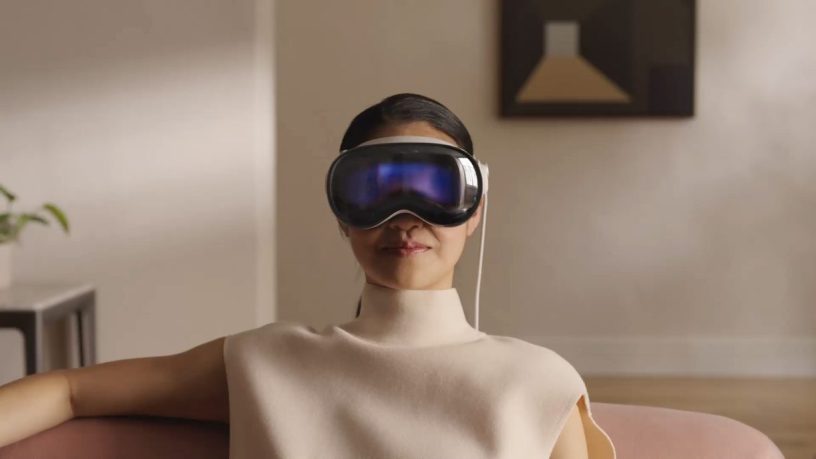By Phillip Swann
The TV Answer Man –Follow on & X.
Former Sony employee and editor of 4 TV magazines.
Apple today at 8 a.m. ET will begin taking pre-orders for the Apple Vision Pro with the Virtual Reality headset available in all Apple retail and online stores on February 2.
Let me make a confession. I want a Vision Pro. I really want one. The thing can display movies, web sites, apps (although not Netflix and some others) and anything else you can think of on virtual displays as wide as 100 feet. Whoa. Who wouldn’t want that?
But I am a tech geek. I tend to want things that are expensive and completely unneeded. That doesn’t mean I get them, of course. And at $3,499, I will probably never get a Vision Pro. And I suspect very few others will get it, either, even if the price comes down $1,000.
Apple, which unveiled the Vision Pro at last year’s Worldwide Developers Conference, is following fellow tech giants Meta and Microsoft in chasing the dream that Virtual Reality will ultimately transform the way we do almost everything.
The buzz that surrounds VR comes from an awareness that every several years an emerging technology begins to reshape our culture. The new product liberates us to explore previously unseen opportunities in both our professional and personal lives. The behavioral shift leads to widespread change in the way we do business and relate to others.
See more news and TV tech features at TVAnswerMan.com.
In recent years, Apple’s iPhone certainly falls into that category.
But more times than not, the buzz turns out to be hype, and the product/technology never reaches the masses. It will either flop entirely, or simply become something that’s used by a relatively small number of people, a niche.
 Despite being available for several years now, Virtual Reality is still just a niche with moderate sales at best, and it says here that it will stay that way no matter what Apple, Meta or Microsoft does.
Despite being available for several years now, Virtual Reality is still just a niche with moderate sales at best, and it says here that it will stay that way no matter what Apple, Meta or Microsoft does.
Why? Four reasons:
1. It doesn’t fulfill an urgent need.
(Examples of products that do: The microwave. The smart phone.)
This is where I have a major problem with VR. I don’t know what the urgent need is. I can understand that some people would find it fun in gaming and other entertainment activities. But does even that subset of society have an urgent need to don the goggles and virtually scan the surroundings of a display?
For a product to truly alter our culture, there has to be that kind of pressing need and I’m not seeing it with VR. There’s a big difference between leisure activity and need.
Perhaps Apple can create that need. But in a post-Covid world, I’m not sure there’s as much appeal there as Apple might think. Aren’t we all tired of being isolated?
2. It doesn’t make the lives of most people more appealing and/or entertaining.
Examples of products that do: Mobile Music. Streaming Video.
Virtual Reality enthusiasts say a well-done VR program or enhancement adds enormous appeal and entertainment. I’m not sure if I see it yet, but I will take their word on it for now.
But to date, only a small number of people (gamers mostly) are using Virtual Reality on a regular basis.
In fact, most people are not seeing any reason to use it, or in some cases, they actually see a reason not to use it because it elicits feelings of physical uneasiness. (Yes, you can get sick.) For a product to reach the masses, the masses have to be excited about using it and there’s little or no evidence of that happening.
 3. It doesn’t provide more options in our lives.
3. It doesn’t provide more options in our lives.
Examples of products that do: Streaming video.
A Virtual Reality feature that enhances a game or TV show does not really provide more options; it just supplements the existing option. You would have played the game or watched the TV show anyway, right?
However, you could argue that a VR program that stands separately from an existing piece of content does provide a new entertainment option. Without the VR program, that option would not exist. But it’s uncertain if the new entertainment choice will be appealing and entertaining. If it’s not, VR would fail on rule #3.
4. It doesn’t add convenience or is easy to use.
Example of products that do: E-Mail. Text. Social Media.
And this is where I have another major problem with Virtual Reality. Most VR experts say the technology is still a work in progress. Some VR headsets work well; some don’t. Some VR programs offer striking views while others are a blurry mess. Some goggles are a pain to fit on your head while others, well, okay, almost all goggles are a pain to fit on your head. (And early reviews say the VisionPro feels heavy on the head.)
There are also compatibility problems (one program works with your iPhone, but not Android, and so on.)
‘Easy to use’ is not necessarily the first thing you would think of when asked about Virtual Reality.
So to sum up. Virtual Reality, like many new technologies, is intriguing because it flirts with some of our four rules to success. But as of now, it falls short on at least three of them. Consequently, I could not predict that VR will be a ‘next big thing,’ but rather the next niche thing.
Have a question about new TV technologies? Send it to The TV Answer Man at swann@tvanswerman.com Please include your first name and hometown in your message.
The TV Answer Man is veteran journalist Phillip Swann who has covered the TV technology scene for more than three decades. He will report on the latest news and answer your questions regarding new devices and services that are changing the way you watch television. See the bio for Phillip Swann here.


